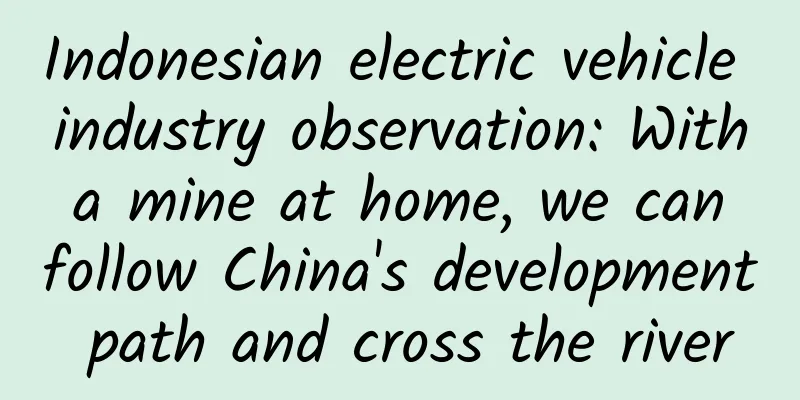Indonesian electric vehicle industry observation: With a mine at home, we can follow China's development path and cross the river

|
Indonesia is the largest economy in Southeast Asia, with the largest population and area, and a relatively large automobile industry. According to data from the Indonesian Motor Vehicle Industry Association, Indonesia's motor vehicle production ranks 11th in the world, and domestic sales rank 14th in the world, and it exports to 93 countries and regions around the world. So far, Indonesia has more than 20 automobile companies, with a production of 1.4 million vehicles last year, making it the second largest automobile producer in Southeast Asia after Thailand; in August 2024, Indonesia's new car sales reached 76,304 units, a year-on-year decrease of 14.2%, but it is still one of the important automobile producers in Southeast Asia. New energy vehicles are becoming the biggest highlight of Indonesia's automotive industry. Data shows that from January to August 2024, Indonesia's pure electric vehicle sales reached 23,330 units, more than twice the same period last year, with an astonishing growth rate. Behind all this, Chinese manufacturers are flashing. BYD only entered the Indonesian market in June this year, but has already delivered a total of 6,461 electric vehicles, with the main models being the Seal and Yuan PLUS. Wuling Motors also performed well, with a total of 3,876 Wuling Bingo vehicles delivered from January to August and 1,655 Wuling Air vehicles sold. Chery Automobile also made gains in the Indonesian electric vehicle market, with a total of 3,485 Omenda E5 vehicles delivered from January to August. This market structure is similar to the Thai market. Their traditional fuel vehicle market is dominated by Japanese manufacturers, while the electric vehicle market is occupied by Chinese manufacturers and is in a rapid development process. There are very few countries in the world that truly have a complete automotive industry chain. Indonesia, like Thailand, is a country with a certain automotive industry foundation, but due to various reasons, it has always lacked upward industrial momentum. Indonesia's electric vehicle industry faces various problems, including insufficient infrastructure construction, poor supporting capacity of the industrial chain, reliance on imports of key components, weak performance of domestic independent brands, and low independent research and development capabilities. Generally speaking, to solve such problems, countries such as Thailand, Hungary, and Mexico have taken measures to attract investment and use various preferential policies to attract large new energy vehicle manufacturers from other countries to invest and set up factories, thereby achieving industrial chain transfer and technology diffusion. Indonesia naturally has the same idea, and compared with other countries, Indonesia has a unique advantage, that is, it has mines at home. The key to electric vehicles lies in power batteries, and the key to power batteries lies in upstream raw materials such as nickel, cobalt and manganese. These raw materials are relatively scarce in China, the United States and the European Union, the three major electric vehicle centers. But Indonesia is different. It is the world's largest nickel producer and the second largest cobalt producer. Such resource advantages give Indonesia influence on the global electric vehicle market. The Indonesian government's approach is to restrict or prohibit the export of key raw materials based on the nickel and cobalt resources in its hands, while expanding openness and requiring industrial chain giants from other countries to invest and set up factories in Indonesia, trying to use this as a starting point to build a complete power battery industry chain. So far, German chemical giant BASF, French nickel giant Eramet, South Korean battery giant LG, Chinese battery giant CATL, and global nickel giant Tsingshan Holdings have all entered Indonesia's nickel mining industry. In addition, the Indonesian government has positioned the electric vehicle industry as one of the 18 pioneer industries. According to the Indonesian government's plan, by 2030, the country will have an annual production capacity of 500,000 electric vehicles, at least 2.2 million electric vehicles, and will only sell electric vehicles by 2050. In addition, the Indonesian government also stipulates that for new energy vehicles that invest and set up factories in Indonesia, more than 40% of their products must use local Indonesian parts before 2026. In order to promote the development of electric vehicles, the Indonesian government has also decided to strengthen infrastructure construction. The development plan of supporting infrastructure for electric vehicles has been written into Indonesia's "National Medium-term Development Plan 2020-2024", and a charging station network is planned and built across the country. So far, Indonesia's charging infrastructure is still relatively backward, and many users are forced to choose non-plug-in hybrid vehicles dominated by Japanese manufacturers. Due to China's strong position in the global new energy market, foreign investors in the Indonesian market are mainly Chinese manufacturers. So far, the vehicle manufacturers that have entered the Indonesian electric vehicle market include Wuling, Seres, Chery, FAW, BYD, Nezha, Great Wall, GAC Aion, and other vehicle manufacturers, as well as power battery manufacturers such as CATL, EVE Energy, and Guoxuan High-tech, and raw material manufacturers such as Tsingshan Holdings, Zhongwei Shares, and B&T. Judging from the current situation, Indonesia is still relatively stable in the development of electric vehicles. At this stage, it focuses on introducing foreign manufacturers, obtaining technology diffusion, completing the industrial chain, and improving infrastructure. In the future, it is possible to cultivate local new energy vehicle brands. This idea is actually quite close to that of China. In fact, Indonesia is indeed following China's successful path in all aspects and is expected to become another model country for the success of the Chinese model in Southeast Asia in the future. As a winner of Toutiao's Qingyun Plan and Baijiahao's Bai+ Plan, the 2019 Baidu Digital Author of the Year, the Baijiahao's Most Popular Author in the Technology Field, the 2019 Sogou Technology and Culture Author, and the 2021 Baijiahao Quarterly Influential Creator, he has won many awards, including the 2013 Sohu Best Industry Media Person, the 2015 China New Media Entrepreneurship Competition Beijing Third Place, the 2015 Guangmang Experience Award, the 2015 China New Media Entrepreneurship Competition Finals Third Place, and the 2018 Baidu Dynamic Annual Powerful Celebrity. |
<<: How big is the gap between Xiaomi's self-developed processor and Qualcomm and Huawei?
>>: It is better to consider iPhone 6s when buying an Android flagship. Do you agree?
Recommend
7 Nobel Prize winners gathered at the West Lake, and the most talked about topic was whether you and I could keep our jobs.
In order to find out the reason why some strange ...
Sohu wins 2014 World Cup video rights, portal + video creates differentiated services
On May 7, Sohu announced a partnership with CNTV,...
How to plan an awesome online event!
How to plan a marketing campaign that is economic...
Niu Ge Practical Training Camp Phase 4
Brief introduction to the resources of the fourth...
Tik Tok promotion skills: 3 steps and 7 key points!
I don’t know since when, the paper advertisements...
Apples vs. pears, which one is easier to preserve? | There is great science in life
Today we are going to talk about two very common ...
5 basic skills for brand private domain implementation!
After experiencing the epidemic in 2020, brands a...
From "Music Review Special Train" to "Xigua Video Celebrity Ticket", what else can subway advertising do?
It’s been almost a year since the heart-wrenching...
The first Chinese female winner of the American Mathematics Award! She said: I am just an ordinary person
The only Chinese girl who participated in the com...
Two women in Henan were poisoned after eating cold noodles. How toxic is the fumonisin that cannot be killed by high temperature? Be careful with these foods
According to media reports, on July 3, two women ...
Yellow fog warning issued! Affecting 8 provinces, please check this safety guide before going out →
The Central Meteorological Observatory continued ...
APICloud has been working hard for six years to build a low-code development platform with persistence and innovation
[51CTO.com original article] The rapid developmen...
How to successfully implement mobile device management
Thanks to increased operating system capabilities...
Line Korea Technical Manager Shin Seung-yong will attend the Cocos Developer Conference
The Cocos 2014 Developer Conference (Autumn) will...
Mixed positioning has hidden dangers, power reduction is confirmed, and the future of Citroen C4 Capgemini's listing is uncertain
On November 1, the first model of SAIC-GM-Wuling ...









